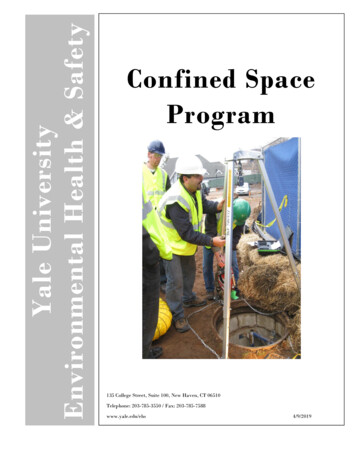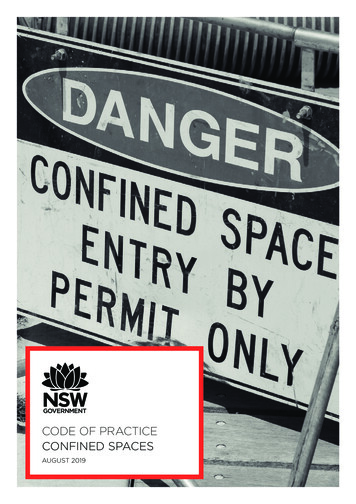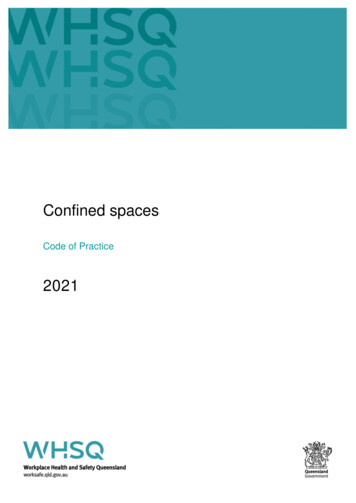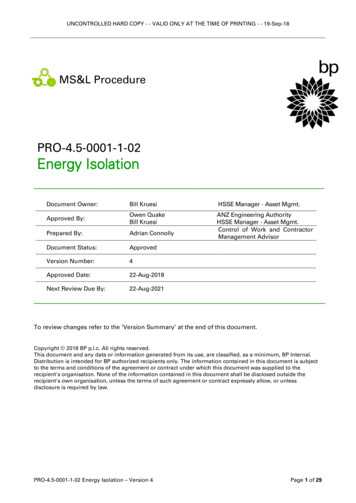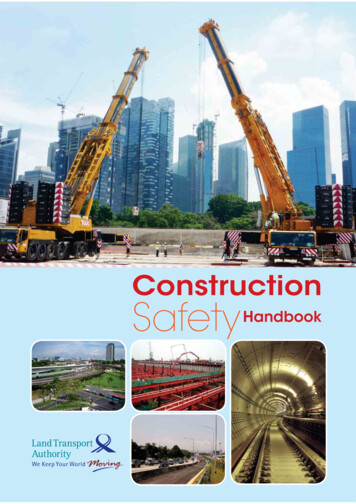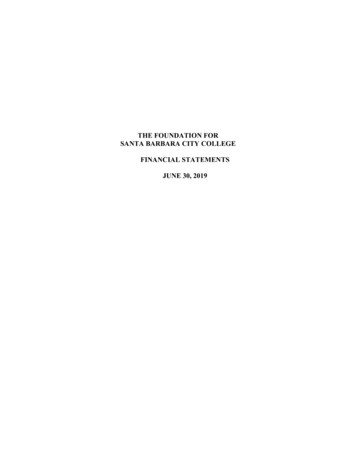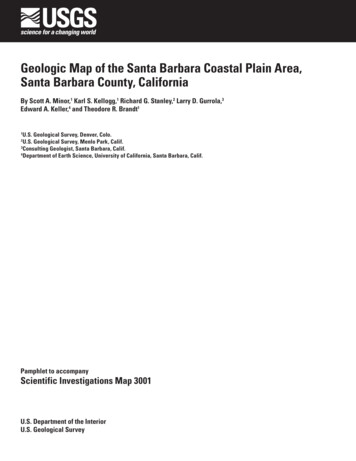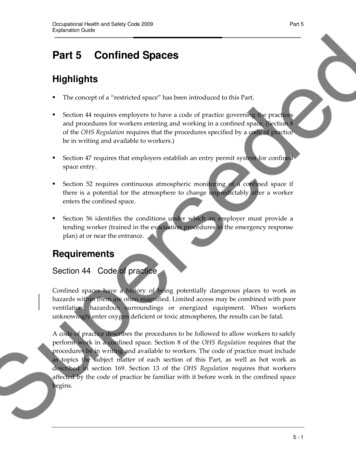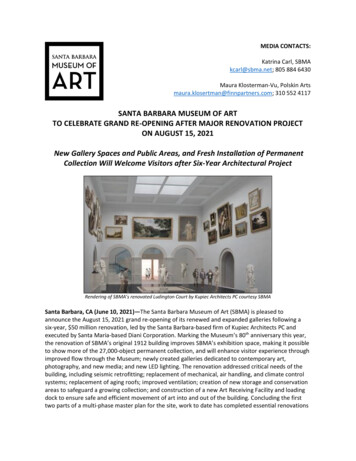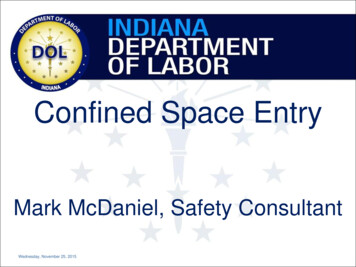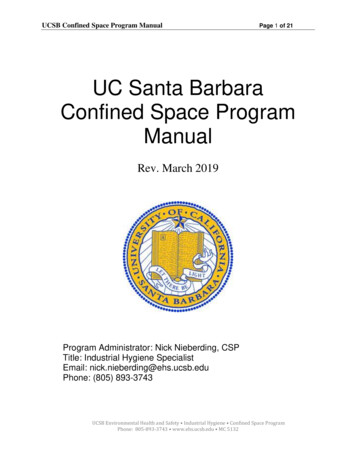
Transcription
UCSB Confined Space Program ManualPage 1 of 21UC Santa BarbaraConfined Space ProgramManualRev. March 2019Program Administrator: Nick Nieberding, CSPTitle: Industrial Hygiene SpecialistEmail: nick.nieberding@ehs.ucsb.eduPhone: (805) 893-3743UCSB Environmental Health and Safety Industrial Hygiene Confined Space ProgramPhone: 805-893-3743 www.ehs.ucsb.edu MC 5132
UCSB Confined Space Program ManualPage 2 of 21Table of ContentsI.Purpose/Introduction .3II.Applicability/Scope .3III.Responsibilities. 3IV.Definitions .6V.Confined Space Classification and Hazards .9VI.Training .11VII. Confined Space Entry Procedures .13VIII. Telecommunications .17IX.Emergency and Non-Entry Rescue Procedures .17X.References .17XI.Issued By and Next Review Date .17XII. Attachments .17
UCSB Confined Space Program ManualPage 3 of 21I. Purpose/IntroductionWorking in confined spaces poses an increased hazard to workers for a variety of reasons. Hundreds ofworkers are injured or killed while working in confined spaces each year. An estimated 60% of the fatalitieshave been among the would-be rescuers. The principal objective of the UCSB Confined Space Program is toestablish practices and procedures that ensure the health and safety of personnel entering and working incampus confined spaces. This objective is met by:1. Ensuring all campus confined spaces are identified and correctly classified.2. Posting appropriate signage and providing training, so individuals recognize confined spaces and donot enter unless authorized.3. Authorizing individuals to work in confined spaces and ensuring they have received proper training.4. Implementing procedures to ensure safe and legal entry into campus confined spaces. Note: As ofthe publishing date of this manual, all known UCSB permit-required confined spaces can bereclassified to non-permit spaces before entry. UCSB personnel must not enter permit-spacesuntil they have reclassified to a non-permit space using the procedures outlined in this manual.If a space cannot be reclassified, entry must not take place.This program has been designed to comply with Cal/OSHA Section 5157. Telecommunication utilityholes/vaults are regulated under Cal/OSHA Section 8616.II. Applicability/ScopeThe UCSB Confined Space Program, through the requirements described in this manual, establishesprocedures and responsibilities for UCSB students, faculty, staff, volunteers, and visitors while engagedin University-related activities. These requirements are based on the California Code of Regulations, Title8, Section 5157, Permit-Required Confined Spaces.III. ResponsibilitiesA. Department Heads and ChairsDirectors and Department Chairs are responsible for: Ensuring departmental compliance with campus health and safety policies and procedures;Providing the necessary resources to ensure the health and safety of their employees;Identifying individuals as supervisors and ensuring they are trained on their health and safetyresponsibilities; andEnsuring departmental workplace hazards are identified and controlled.B. Space Owners (Departments and PIs)Space Owners are responsible for:Space IdentificationSpace owners are responsible for ensuring to all confined spaces under their control have identified, andevaluated by the program administrator. Each space owner must maintain a local confined space inventory.A master inventory for the campus is maintained by the confined space program administrator, with updatesinitiated by the space owner as needed.
UCSB Confined Space Program ManualPage 4 of 21LabelingSignage for non-permit required confined spaces is not required; however it is recommended for spaces thatmay be accessed by untrained personnel. Recommended signage is as follows:CAUTIONCONFINED SPACEAUTHORIZED PERSONNEL ONLYPermit-required spaces, which could be inadvertently entered, must be labeled as a permit-required confinedspace using the following language:DANGERPERMIT-REQUIRED CONFINED SPACEDO NOT ENTERContractor AwarenessWhen the space owner arranges to have employees of another employer perform work that involves confinedspace entry, they must: Notify the program administrator prior to entry, and as far in advance as possible;Inform the contractor, in writing, that the workplace contains confined spaces and that permitspace entry is only allowed through compliance with a permit space program meeting therequirements set forth by Cal/OSHA (e.g. California Code of Regulations, Title 8, Section 5157);Apprise the contractor of any precautions or procedures that the host employer has implementedfor the protection of campus personnel in or near the confined space where contractor personnelwill be working;Apprise the contractor of the elements, including the hazard(s) identified and the campus’sexperience with the space, that make the space in question a permit-required confined space.Coordinate entry operations with the contractor when both campus personnel and contractorpersonnel will be working in or near confined spaces; andConsult with the contractor at the conclusion of entry operations regarding any hazardsconfronted or created in confined spaces during entry operations.All records associated with the above section must be maintained as a part of the permanent record with theterminated entry permit(s).EH&S NotificationSpace owners must notify the program administrator immediately if any of the following occur: Unauthorized entry of a permit space.The occurrence of an injury or near-miss during a confined space entry.A change in the use or configuration of a confined space.C. Managers, Supervisors, and Principal InvestigatorsSupervisors have the primary responsibility for ensuring the health and safety of their supervisees. Specificconfined space responsibilities include: Identifying confined spaces that personnel may enter and ensuring they have been reviewed andclassified by the program administrator;Designating persons who are to have active roles (as, for example, authorized entrants, attendants,entry supervisors, or persons who test or monitor the atmosphere) in entry operations, identify theduties of personnel and provide personnel with the training required;
UCSB Confined Space Program Manual Page 5 of 21Ensuring personnel receive the proper level of training and that training is documented;Ensuring hot work is authorized through the Campus Fire Marshal on a separate hot work permit andattached and noted on the permit space reclassification form;Ensuring copies of all permit space reclassification forms are retained by the department and a copyis submitted to the program administrator;Developing and implementing special procedures for confined space entry as needed; andNotifying the program administrator of unauthorized entry of a permit space, or an injury or nearmiss during a confined space entry.D. Outside ContractorsA copy of UCSB’s Confined Space Program will be made available to contractors upon request. Contractorsare expected to fully comply with safety and health standards issued by the California Department forOccupational Safety and Health (Cal/OSHA). Each contractor who is retained to perform work that willrequire permit space entry operations must: Furnish a written permit space program that complies with Cal/OSHA regulations;Obtain any available information regarding permit space hazards and entry operations from the spaceowner;Coordinate entry operations with the space owner when both the contractor and campus personnelwill be working in or near permit spaces; andInform the space owner, either during a debriefing or during entry operations, of the procedures thatthe contractor will follow and of any hazards confronted or created in permit spaces.E. Employees, Students, Volunteers, and VisitorsEmployees, Students, Volunteers, and Visitors are responsible for: Understanding and complying with campus health and safety policies and procedures; andNotifying their supervisor or EH&S about any hazardous conditions observed on the worksite.F. Office of Environmental Health and Safety (EH&S)The UCSB Confined Space Program is administered by the Office of Environmental Health and Safety.EH&S is responsible for: Designating an individual who is qualified by appropriate training and/or experience toadminister the program.G. Program AdministratorThe Program Administrator functions as a technical resource to departments and assists them in carrying outtheir responsibilities as necessary. Additionally, the program administrator is responsible for: Developing and maintaining the UCSB Confined Space Program and ensuring it meets allapplicable regulatory requirements;Assisting departments in identifying and classifying confined spaces;Assisting with atmospheric testing and equipment selection as needed;Developing and providing confined space entry training;Reviewing all permit space reclassification forms on an annual basis;Maintaining a master list of campus confined spaces;Assisting departments and supervisors in performing hazard assessments when requested, andrecommending appropriate controls; andAssessing the effectiveness of the program as described in this document.
UCSB Confined Space Program ManualPage 6 of 21IV. Definitions“Acceptable entry conditions” means the conditions that must exist in a space to allow entry and to ensurethat personnel involved with a confined space entry can safely enter into and work within the space.“Atmosphere-controlled confined space” means a permit-required confined space in which potential oractual atmospheric hazards can be eliminated prior to entry or can be controlled with continuous forcedmechanical ventilation."Atmospheric testing" or "testing" means the process by which atmospheric hazards are identified andevaluated. Testing includes specifying the tests that are to be performed prior to entering a space. If electronicor thermal equipment is used to perform such tests, and the possibility exists of an explosive substance or ahazardous atmosphere due to flammable gases and vapors, then the testing equipment must be approved foruse in such explosive or flammable conditions as required by section 2540.2.“Attendant” means an individual stationed outside a permit space or a reclassified permit space whoperforms attendant’s duties as required by this program.“Blanking or blinding” means the absolute closure of a pipe, line, or duct by the fastening of a solid plate(such as a spectacle blind or a skillet blind) that completely covers the bore and that is capable ofwithstanding the maximum pressure of the pipe, line, or duct with no leakage beyond the plate.“Cal/OSHA” means California Department for Occupational Safety and Health.“Confined space” is any space that is large enough and so configured that personnel can bodily enter andperform assigned work, has limited or restricted means for entry or exit and is not designed for continuouspersonnel occupancy. Confined spaces may include, but are not limited to: storage tanks, pits, vats, vessels,environmental chambers, utility holes, vaults, pump or lift stations, septic tanks, boilers, pipelines, tunnels,ventilation and exhaust ducts, trenches, and excavations.“Control measure” means a system or device used, or action taken, to control or prevent the introduction ofphysical hazards into a confined space.“Department” means any UCSB department that performs work in a confined space or a reclassifiedpermit-required confined space. This includes, but is not limited to Facilities Management, Design andConstruction Services, Communications, and EH&S.“Double block and bleed” means the closure of a line, duct, or pipe by closing and locking or tagging twoin-line valves by opening and locking or tagging a drain or vent valve in the line between the two closedvalves.“Emergency” means any occurrence or event inside or outside of a confined space that could endangerentrants.“Engulfment” means the surrounding of a person by finely divided solids or a liquid. A worker in a storagetank filled with sawdust, for example, could fall into an air pocket, be surrounded entirely by sawdust, andsuffocate to death.“Entrant” means personnel or contractor who enters a confined space.“Entry” means any action resulting in any part of an individual’s body breaking the plane of any opening ofa confined space, and includes any work activities inside the confined space.
UCSB Confined Space Program ManualPage 7 of 21“Entry permit” or “permit” means the written or printed document that is provided by the employer toallow and control entry into a permit space.“Entry supervisor” or “supervisor” means the departmental person responsible for determining if spacewhere entry is planned, for authorizing entry and overseeing entry operations, and for terminating entry asrequired by this document.“Ground-fault circuit-interrupter” is a device designed to disconnect an electric circuit when it seeksground through a person or a grounded object, thus preventing electric shock and fires.“Hazardous atmosphere” means an atmosphere that may expose employees to the risk of death,incapacitation, impairment of ability to self-rescue (that is, escape unaided from a permit space), injury, oracute illness from one or more of the following causes: A flammable gas, vapor or mist in excess of 10% of its lower flammable limit (LFL);An oxygen-deficient atmosphere containing less than 19.5% oxygen by volume or an oxygenenriched atmosphere containing more than 23.5% oxygen by volume;Airborne combustible dust at a concentration that meets or exceeds its LFL (airborne combustibledust which obscures vision at five feet or less);An atmospheric concentration of any substance for which a dose is published in Group 14 forRadiation and Radioactivity, or a permissible exposure limit is published in Section 5155 forAirborne Contaminants which could result in personnel exposure in excess of its dose or permissibleexposure limit, and that could cause death, incapacitation, impairment of ability to self-rescue, injuryor acute illness; orAny other atmospheric condition that is immediately dangerous to life or health (IDLH).“Hot work permit” means the campus’ written authorization to perform operations (for example, welding,cutting, burning or heating) capable of providing a source of ignition.“Immediately dangerous to life or health (IDLH)” means any condition that poses an immediate ordelayed threat to life, or that would cause irreversible adverse health effects, or that would interfere with anindividual's ability to escape unaided from a space.“Inerting” means the displacement of the atmosphere in a permit space by a noncombustible gas (such asnitrogen) to such an extent that the resulting atmosphere is noncombustible. Note that this procedureproduces an IDLH oxygen-deficient atmosphere that can only be entered using self-contained breathingapparatus (SCBA).“Isolation” means the process by which a permit space is removed from service and completely protectedagainst the release of energy and material into the space by such means as: blanking or blinding; misaligningor removing sections of lines, pipes, or ducts; a double block and bleed system; Lockout-tagout of all sourcesof energy; or blocking or disconnecting all mechanical linkages.“Lockout-tagout” means placing locks and tags on the energy isolating device (e.g. breaker boxes, controlswitches, valves, etc.) to prevent the unauthorized re-energization of the device or circuit while work is beingperformed by personnel. Tags must indicate that the energy isolated device must not be operated until thelock and tag are removed by the individual(s) who installed them.“Non-permit confined space” or “non-permit space” means a confined space that does not contain or,with respect to atmospheric hazards, have the potential to contain any hazard capable of causing death orserious physical harm
UCSB Confined Space Program ManualPage 8 of 21“Permit space reclassification form” or “reclassification form” means the form used to document thereclassification of a permit space to a non-permit space.“Permit-required confined space” or “permit space” means a confined space that has one or more of thefollowing characteristics: Contains or has the potential to contain a hazardous atmosphere;Contains a material that has the potential for engulfing an entrant;Has an internal configuration such that an entrant could be trapped or asphyxiated by inwardlyconverging walls or by a floor which slopes downward and tapers to a smaller cross-section; orContains any other recognized serious safety or health hazard (such as noise, welding, electricity,radiation, or moving parts of machinery).“Permit-required confined space program” means the campus’s overall program for controlling and,where appropriate, for protecting personnel from, permit space hazards and for regulating personnel entryinto permit spaces.“Permit system” means an employer's written procedure for preparing and issuing permits for entry and forreturning the permit space to service following termination of entry.“Program administrator” means the individual appointed by the Office of Environmental Health andSafety (EH&S) who is qualified by appropriate training and/or experience to administer the program.“Prohibited condition” means any condition in a reclassified permit space that is not allowed during theperiod when entry is authorized.“Reclassified permit-required confined space” or “reclassified permit space” means a permit-requiredconfined space that has been temporarily reclassified to a non-permit required confined space.“Rescue team” mean those persons whom the employer has designated prior to any permit-requiredconfined space entry to perform rescues from confined spaces.“Retrieval system” means the equipment used for non-entry rescue of persons from reclassified permitspaces, and includes retrieval lines, chest or full body harness, and a lifting device or anchor. A retrieval lineis primarily of use in vertical confined spaces, and must not be used in confined spaces consisting ofhorizontal tunnels or spaces where obstructions could increase the hazard to the entrant during emergencynon-entry removal.“Serious hazard” means a hazard where there is a substantial probability that death or serious physical harmcould result. A serious injury or illness is one that requires employee hospitalization for more than 24 hoursfor other than medical observation, or in which a part of the body is lost or permanent disfigurement occurs.“Space owner” means the department or individual who owns, controls access, or has the primaryresponsibility for overseeing a confined space.“Telecommunications” means a science dealing with the provisions of Communication Service.“Zero mechanical state” means that the mechanical potential energy of all portions of the machine orequipment is set so that the opening of the pipe(s), tube(s), hose(s) or actuation of any valve, lever, or buttonwill not produce a movement which could cause injury.
UCSB Confined Space Program ManualPage 9 of 21V. Confined Space Classification and HazardsConfined spaces can be below or above ground, and may be found in almost any workplace. A confinedspace, despite its name, is not necessarily small. Examples of confined spaces include silos, vats, hoppers,utility vaults, tanks, sewers, pipes, access shafts, truck or rail tank cars, aircraft wings, boilers, utilityholes, manure pits, and storage bins. Ditches and trenches may also be a confined space when access oregress is limited.A. Space Evaluation and ClassificationSpace owners must ensure all identified confined spaces have been evaluated and classified as a non-permitor permit-required confined space by the program administrator. A non-permit required confined spacemeets the definition of a confined space, and does not contain or, with respect to atmospheric hazards, havethe potential to contain any hazard capable of causing death or serious physical harm. A permit-requiredconfined space is a confined space which contains a recognized serious safety or health hazard, or thepotential to contain a hazardous atmosphere. The full definitions of a confined space and a permit-requiredconfined space are below:A confined space is a space which has all three of the following characteristics:1. Large enough for personnel to enter and perform assigned work;2. Has limited or restricted means for entry or exit; and3. Is not designed for continuous personnel occupancy.A permit-required confined space (PRCS) is a confined space that has one or more of the followingcharacteristics:1. Contains or has the potential to contain a hazardous atmosphere;2. Contains a material that has the potential for engulfing an entrant (e.g. water, sand, dirt);3. Has an internal configuration such that an entrant could be trapped or asphyxiated by inwardlyconverging walls or by a floor which slopes downward and tapers to a smaller cross-section, or,4. Contains any other recognized serious safety or health hazard.Space EvaluationThe atmosphere of a confined space should be analyzed using equipment of sufficient sensitivity andspecificity to identify and evaluate any hazardous atmospheres that may exist or arise, so that appropriatepermit entry procedures can be developed and acceptable entry conditions stipulated for that space.Evaluation and interpretation of these data, and development of the entry procedure, will be done, orreviewed by the program administrator based on evaluation of all serious hazards. using UCSB ConfinedSpace Evaluation Form (Attachment B).B. Confined Space HazardsThe following are common confined space hazards that would require a space to be classified as a permitrequired confined space:Hazardous AtmospheresHazardous atmosphere means an atmosphere that may expose employees to the risk of death,incapacitation, impairment of ability to self-rescue (that is, escape unaided from a permit space), injury,or acute illness from one or more of the following causes. A space containing a hazardous atmospheremust not be entered under any circumstance. Some examples of common hazardous atmospheres are:Oxygen-Deficient Atmospheres: An oxygen-deficient atmosphere has less than 19.5% available oxygen.Any atmosphere with less than 19.5% oxygen must not be entered unless personnel have been properly
UCSB Confined Space Program ManualPage 10 of 21trained and have an approved self-contained breathing apparatus (SCBA). This is an atmosphere that isImmediately Dangerous to Life and Health (IDLH). Oxygen deficient atmospheres may develop in thefollowing situations: Ambient oxygen is consumed by the work being performed, such as welding, cutting or brazing, or itcan be decreased by certain chemical reactions (for example, the rusting of metal) or throughbacterial action; orAmbient oxygen is displaced by another gas, such as carbon dioxide or nitrogen (inerting).Oxygen-Enriched Atmospheres: Oxygen enrichment refers to air containing more than 23.5 percentoxygen. This dangerous condition is an extreme fire hazard in which static electricity from materials suchas hair or clothing can provide the ignition source needed to start a fire. This environment also allows anyfire to burn more readily. Oxygen enrichment does not occur naturally and should be investigated.Flammable atmospheres: Different gases have different flammable ranges. An atmosphere is consideredhazardous if the concentration of any substance exceeds 10% of its lower explosive limit (LEL). If a sourceof ignition (such as a sparking or electrical tool) is introduced into a space with a flammable atmosphere, anexplosion could result.Toxic atmospheres: Most substances (liquids, vapors, gases, mists, solid materials, and dusts) can present ahazard in a confined space. Toxic atmospheres contain an atmospheric concentration of one or moresubstances at or above their Permissible Exposure Limits (PEL), and include any other atmosphericconditions that are IDLH. Toxic substances can come from the following: A product stored in the space;The work being performed in the space. Examples include welding, cutting, brazing, painting,scraping, sanding, degreasing, use of solvents, etc; orToxic materials stored in areas adjacent to the confined space. Examples include chemicals or fuelstored in leaking underground storage tanks, or sections of the steam tunnels that may overlay or lieadjacent to a leaking sewer system.Non-Atmospheric HazardsAdditional serious hazards which should be evaluated and may require a confined space to be classified as apermit-required confined space include but are not limited to:Hazardous Energy: Confined spaces may contain hazards from electrical, mechanical, pneumatic orhydraulic energy sources. Hazardous energy sources must be identified and mitigated using proper energyisolation procedures prior to entry. Lockout-tagout (LOTO) refers to the safety procedures used to ensurethat dangerous equipment has been properly shut-down and is incapable of being started up again prior to thecompletion of the entry or servicing work. It requires that all hazardous energy sources have been (1)identified (2) isolated and (3) rendered inoperative. Some common forms of energy isolation includeelectrical circuit breakers, disconnect switches, ball or gate valves, blind flanges, and blocks. Push buttons, estops, selector switches, and control panels are not considered proper points for energy isolation. Types ofenergy that may need to be isolated include potential energy (mechanical springs in tension orcompression, compressed gas cylinders, counterweights, etc.), kinetic energy (rotating flywheel/shafts,moving parts, rolling components, parked vehicles, etc.) and utility energy (electricity, compressed air,steam, domestic water, etc.). For more information on Energy Isolation and LOTO procedures, pleasecontact UCSB Industrial Safety Services nt Hazards: Examples of entrapment hazards in confined spaces include inwardly convergingwalls or floors that slope downward and taper to a smaller cross-section (such as air plenums).
UCSB Confined Space Program ManualPage 11 of 21Engulfment Hazards: This refers to the surrounding or burial of the worker in a liquid or loose, finelydivided solid material, such as sand or grain. Such materials can suffocate a worker. Examples include: Accidental dumping of a product on a worker.A worker walking on unstable material such as settled grain.Thermal Hazards: A thermal hazard is a dangerous condition caused by excessive heat or cold or a hotsurface. Personnel engaged in continuous heavy work while wearing PPE (e.g., bodysuit and respirator) inwarm surroundings are particularly susceptible to thermal hazards. Heat stress may lead to heatexhaustion, heat cramps, heat stroke, loss of consciousness, or death. A permit space reclassification formmust address any hazards from heat or cold within confined spaces.Additional Hazards: Other potentially serious hazards which must be evaluated are biological, animal(snakes, rodents, spiders, etc.), poor lighting, obstructions, falling objects, slip/trip/fall, radioactive andacute chemical hazards.VI. TrainingDepartments are responsible for ensuring personnel are properly trained prior to entering or performingwork in confined spaces. Training must be documented and training records must be kept for as long as itis reasonably expected that an individual will be working in confined spaces. The costs associated with anynecessary equipment or training will be borne by the Department.A. All Confined Space WorkAll personnel involved in confined space work must receive appropriate training in hazard recognition,personal protective equipment, safety equipment, communications equipment, procedures for calling rescueservices and proper use of non-entry rescue equipment as needed. This training must: Be conducted before personnel engage in confined space duties, when there is a change inassigned duties, whenever there is a change in operations that presents a hazard about whichpersonnel has not previously been trained and whenever the supervisor has reason to believeeither that there are deviations from confined space entry procedures or that there areinadequacies in an individual’s knowledge or use of these procedures;Establish personnel proficiency in their duties and introduce new or revised procedures asnecessary;Be documented and contain each individual's name, the signatures or initials of the trainers, andthe dates of training. The certification must be available for inspection by personnel and theirauthorized representatives; andInclude conditions or work practices that may produce a serious hazard in a non-permit confinedspace that may require that the space is r
UCSB Confined Space Program Manual Page 1 of 21 UCSB Environmental Health and Safety Industrial Hygiene Confined Space Program Phone: 805-893-3743 www.ehs.ucsb.edu MC 5132 UC Santa Barbara Confined Space Program Manual Rev. March 2019 Program Administrator: Nick Nieberding, CSP Title: Industrial Hygiene Specialist
